
Questyle Audio Engineering has thus far received lots of attention for their CMA800R headphone amplifiers. And rightfully so - those amps are extremely nice, a veritable match made in heaven for the Sennheiser HD800. But Questyle doesn't limit themselves to just headphone amps. No, they are a diverse company with expertise in many other areas. For example - a lossless wireless amplifier system for speakers (available with ICEpower monoblock amplification). That device may not fit the HeadFi demographic but it sure looks unique.... I don't recall seeing much else like it on the market. Thus, I can see why "headphone amp" still jumps to mind when we hear the Questyle name, similar to how I think "amps and pre-amps" when I hear the name Parasound. But Parasound has made lots of other great stuff over the years as well, and currently offers one of the finest CD players on the market in my opinion, the Halo CD1. So it's best to keep an open mind when considering these things.
Questyle also does D/A conversion - I covered their Q192 all in one headphone amp/DAC/pre-amp at InnerFidelity and found it to be very impressive when paired with the right headphones - not a ton of drive for difficult headphones, but simpler loads are great and IEMs are spectacular. At $649 it's a relatively affordable all-in-one and I definitely recommend it. But what about a more upscale system? Questyle's CMA800R is $1500 and can be combined to make a $3000 dual mono, fully balanced setup. As good as the Q192 is, we'll want to take full advantage of the very resolving CMA800R with a true high-end source. Enter the Questyle CAS192D ($1500).
Much like the CMA800R is an update of the original CMA800, the CAS192D stems from the original CAS192, with some additional tweaks The main difference? DSD capability. Can't release a new high-end DAC without that these days, can you? Questyle has a twist with their DSD implementation which I'll get to later. But first, some specs and technical info.
DESIGN
The CAS192D is a pure DAC - no volume control, no headphone amp on board. Those are common features in competing products and I tend to hear mixed opinions about the idea. Some find them highly convenient, while others won't ever use them and therefore see them as a waste of resources. I myself could go either way depending on the quality of the implementation in question. Regardless, Questyle chose to do this particular design as a pure DAC, so if you need those features you'll have to look elsewhere (or wait for the upcoming CMA800i which essentially combines CMA800R and CAS192D in one integrated chassis).

While not having volume or headphone amp capabilities, most other expected features are on board. We get a choice of 5 digital filters and defeatable upsampling, allowing for a certain degree of customization to the sound. An OLED display keeps us in the loop as to incoming sample rates and selected options. Around back we get Toslink and coaxial inputs rated for 24-bit/192kHz, and asychronous USB matching that same rate plus adding DSD capabilities. For outputs we get XLR as well as RCA, with both active at the same time. There's really not anything missing except an AES/EBU input - I see less and less of those these days, but I know some folks still value the format.



As for build quality, the CAS192D matches the CMA800R in terms of styling and general workmanship. Which, the way I see it, is a generous compliment. The CNC machined aluminum enclosure looks and feels like something nicer than your typical "affordable" DAC, and again I point out a very Ayre-esque look to the whole affair. My review unit has the older CAS192 branding (no D) but contains the updated internals. It looks quite nice stacked with one or two CMA800R amps - almost like they were made for each other (which, of course, is true).

Note the thick panels - this picture doesn't really do it justice:

Internally, the CAS192D is based around the WM8741 which is the top chip from Wolfson Micro (recently purchased by Cirrus Logic), and is also seen in the popular PS Audio PerfectWave DAC series. Questyle lists Wolfson as a "technology partner" and works in conjunction with their engineers, which means designs have been given a good double-check by qualified experts. Questyle applies their patented Current Mode Amplification system to reduce transient intermodulation distortion (TIMD), which they state reduces digital glare and hardness. The output stage is based around the excellent AD8599 opamps from Analog Devices. Questyle uses their own badging on the receiver chip for USB input - it's a tweaked version of a well known chip used in a few other currently popular DACs. I was able to successfully guess the model (I'm good like that) but to respect Questyle's wishes I'll keep it under my hat. Questyle uses a triple clock structure (or 3X as they call it) meaning three separate ultra-low phase noise clocks for USB, 44.1kHz, and 48kHz and their multiples. There's also a special Questyle branded chip next to the USB receiver, which I suspect is an FPGA used for jitter reduction. Questyle prefers to keep that under wraps... fair enough. But they do say it routes PCM and DSD signals along different paths in keeping with their "True DSD" philosophy (which I still haven't explained, but I'll get to it).
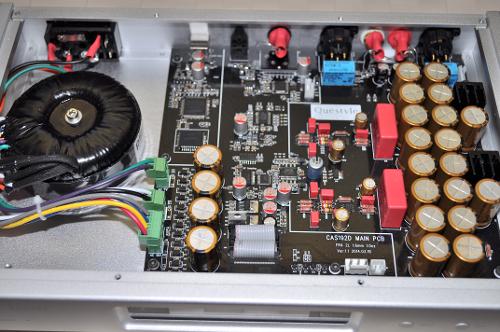
Relays on the outputs:
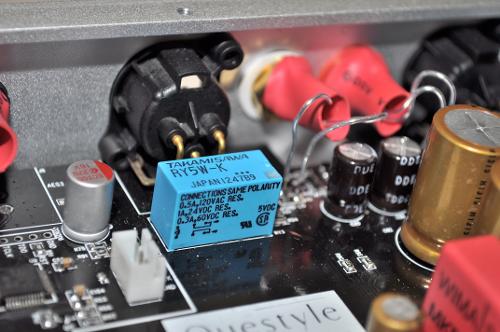
Mystery chip (likely an FPGA):

Proprietary USB implementation:

Output stage:

SRC4192 asynchronous sample rate converter"

Wolfson WM8741 DAC chip:

Special attention was paid to the power supply, using a custom Plitron toroid with Schottky rectifiers and separate windings for digital and analog. The DAC chip itself gets quad voltage regulators, with 16 more spread out across the device. A total of 22 Nichicon FG capacitors in 2200uF flavor add up to nearly 50,000uF of capacitance - which is more in line with an amplifier than a DAC. SPDIF signals are received by a Wolfson WM8805 which features their patented "elastic buffer" for additional jitter reduction. Upsampling is done by a Texas Instruments SRC4192 - when not enabled, that chip gets bypassed, which is theoretically a good thing when dealing with a high quality USB signal and/or material which is already hi-res from the start. Overall the design is very ambitious, with attention paid to every little detail and no compromises to be found.

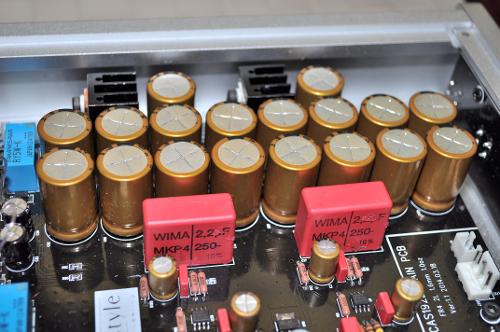
You might notice the choice of 5 digital filters, which is common for the higher end Wolfson chips. Questyle says they started with the internal filters and made some improvements of their own for better performance. Interestingly, playing material in 44.1kHz or 48kHz gives a different set of filter options compared to playing hi-res music. With 88.2kHz and above the filter selection looks like the stock Wolfson set - FIR brickwall, IIR apodizing, FIR apodizing, IIR soft-knee, and FIR soft-knee. Playing 48kHz material or below, the brickwall and linear-phase soft-knee options get swapped out for linear-phase and minimum-phase half-band filters. Which is a good thing as far as I'm concerned - the traditional brickwall filter almost always takes last place in my experience, with the soft-knee filters usually not far behind. It's nice to have options, though personally I have a favorite which I use most of the time.
Quick boot sequence, just takes a few seconds:



Upsampling disengaged:
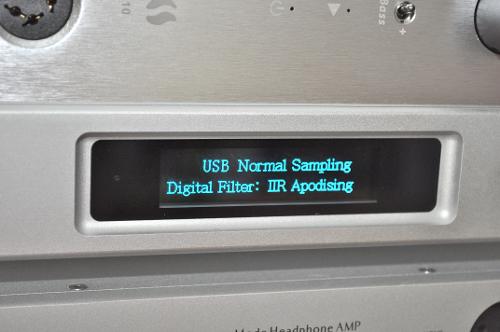
Toslink actually accepts 192kHz which is often claimed but rarely true:

IIR Apodising, my favorite digital filter:

Upsampling engaged:

Note how upsampling is always a direct multiple of the original sample rate:

Different filter:

True DSD playback does no use any digital filtering:

EQUIPMENT
I used a wide variety of gear during this evaluation. The base of the system is an APC S15 power conditioner, with Cabledyne Silver Reference cables all around. I fed the CAS192D over USB with a MacBook Pro running Audirvana, or a Dell Inspiron 17R with JRiver Media Center. I also spun discs with a YBA Design WM202 and later an Arcam FMJ CD37. I sometimes used the Audiophilleo 1 with PurePower as a reference for testing the USB implementation. Amps included the CMA800R (obviously) in single or dual mono configuration, as well as the Auralic Taurus mkII, the Yulong Sabre A28, and the Icon Audio HP8 mkII. For electrostatic goodness I used the KingSound M-10 or a custom built hot-rodded KGSShv. Headphones included the KingSound H3, the Stax SR-007mk2, Sennheiser HD800, Audeze LCD-2 and LCD-3, beerdynamic T1, HiFiMAN HE-6 and HE-500, Alpha Dogs, Noble Kaiser 10, JH13pro FreqPhase, and the Unique Melody Merlin.
T1:
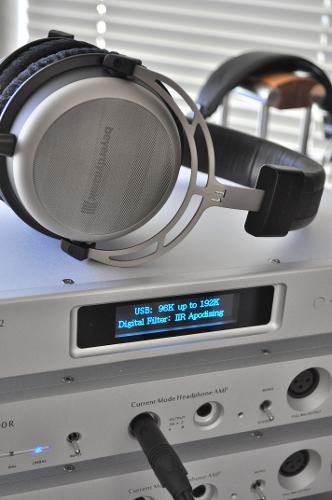
Aurender X100L:

YBA WD202:

Questyle stack with dual mono CMA800R amps:

KingSound electrostatic setup:
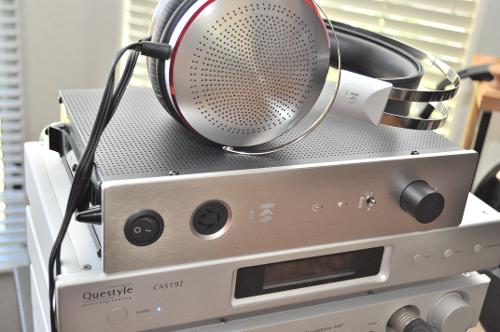
Yulong A28 balanced amp:

Questyle stack, note the Stax O2mkII hiding in the background (KGSShv not shown):

LCD-3:
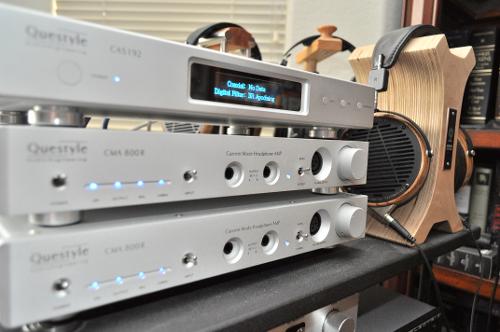
LISTENING
My initial focus was to pair the CAS192D with the CMA800R. I started with just one and later added another for dual mono mode. The result, whether using one or two of the amps, was nothing short of a brilliant match. The CMA800R is a highly resolving amp that will quickly point out flaws in a signal chain, so Questyle had to make sure their flagship DAC was up to the task. At the same time, it would be easy to overdo the detail aspect and make this combo somewhat fatiguing. Thankfully that's not the case here.
No, the CAS192D is not an overly smooth DAC. It's not romantic, relaxed, or forgiving in the least. And yet, it has a sort of unforced clarity to it that allows me to enjoy it for hours without finding it too lit up. This is the sort of thing that makes me question the need for things like NOS DACs, syrupy tube output stages, or other "smoothing" techniques. If people are averse to "digital" sound, the best course of action might just be to seek "better" digital sound, rather than covering it up with a dark, rolled-off design. Once you hear all those details, all that air up top, with deeply carved images and superb localization, it's hard to go back to an amorphous blob-like presentation - compared to something like a Rega DAC ($999), Opera Consonance Orfeo ($1799), or Mojo Audio Mystique ($1949 in upgraded form), the CAS192D is decidedly more insightful yet no less easy to enjoy. In fact the Rega in particular sounds downright slow and dull in direct comparison. I suppose if we only listened to poorly recorded, overly compressed modern music then that sort of thing might be welcome. In most other instances it is definitely not. I don't mean to pick on NOS designs and I realize the Rega is not a NOS design (the Orfeo and Mystique definitely are but all have a similar sound to my ears) - but you see where I'm going with this. "Musical" sounding DACs certainly have their place but there's another approach as well, involving designs like this which are exceedingly clear but also very clean and non-fatiguing.
How about an example by way of comparison? I happen to have an Arcam FMJ CD37 on hand - a $2300 CD/SACD player which also uses the WM8741 (actually two of them on a differential configuration, but who's counting). This is an ideal device for comparing to the CAS192D because they aren't priced too terribly different, and yet they use the same DAC chip. Therefore, they must sound similar, right? Actually, no. Not at all. The Arcam is all about speed and articulation. When used on its own I find it to sound fairly nice if sometimes a bit overly "Hi-Fi". But when compared directly, the Arcam becomes obviously thin and brittle, with midrange and especially bass being inadequately fleshed out. The Questyle is more tonally rich and has a tactile presentation which makes the Arcam seem lean in comparison. Transients, which seem a strong point on the Arcam when used by itself, now just sound etched when viewed in light of the more fluid Questyle. In short, the CAS192D walks away from the comparison. Keep in mind the Arcam was being used as transport to feed the CAS192D so there shouldn't be any discrepancy there. I can see why someone might prefer the smoother Mojo DAC to the Arcam - complaints of "digital" sound come to mind. But I can't for the life of me imagine anyone not wanting to ditch both of those in favor of the Questyle, unless your system is really bright and needs significant taming.
After trying a bunch of different amps and feeding the CAS192D with difference transports, I got a pretty good feel for how it performs in various scenarios. First off, I like it ever so slightly better from the XLR outputs. RCA is quite good too and I have no complaints when I must use them, such as with my Icon Audio SET amp or the KingSound M-10 that only has RCA inputs. But when given the choice due to an amp having both types of inputs, I'll pick XLR.
As for incoming signals - that's an interesting discussion. When using a "standard" USB input (ie, a regular laptop rather than high-end music server) the USB input is just about on par with coaxial SPDIF via my YBA Design WM202. I could make coaxial take the lead by using the Audiophilleo USB to SPDIF converter, or I could make coaxial fall behind through the use of a more pedestrian source - in my case a Dune HD Max media player which was never really designed for higher-end audio. Despite a slight reduction in quality, the Dune over coaxial or optical is still very listenable - particularly when engaging the upsampling feature. As has been the case in other devices I've auditioned, the upsampling is more and more welcome as source/recording quality diminishes. So folks using redbook quality tracks or a more basic transport will likely encounter benefits, while those playing mostly hi-res material over a quality transport or USB will tend to do better with upsampling disengaged. The differences aren't massive but they do exist, making upsampling (and the ability to disable it) welcome.
Back to those digital filters: As usual, I prefer the IIR Apodizing option, so much that I rarely ever use anything else. Again, the differences are not night and day but they are definitely worth messing with. Combined with the upsampling option, you can tweak the sound to best fit your system and your preferences. I did sometimes use the linear-phase half-band filter for a slightly more relaxed/forgiving sound when playing certain Redbook tracks - I believe this filter is custom made by Questyle, and I can see how it could become a favorite as well. Keep in mind that digital filters are never an extreme change from one to the next.... I've heard people say it's like getting 5 distinct DACs in one, which I don't find to be the case at all.
Both the Windows and Mac machines did a fine job over USB. Mac of course needed no drivers, but it did have an issue playing tracks that use the 176.4kHz sample rate. It just wouldn't play them. Windows needed drivers installed as is usually the case with modern asynchronous USB DACs. Once installed, I could play any sample rate without a hitch. DSD? Now that's an interesting topic....
Questyle doesn't use the usual DoP standard for transmitting DSD in a PCM container. Instead, it stays as DSD from start to finish, a fact which Questyle contends improves the resulting sound quality. This does require some hoops be jumped through. Questyle is a "firmware strategy partner" with JRiver and thus recommends their Media Center software, which is actually required to enable DSD playback. I have mixed feelings about that.... on the one hand, JRMC is a brilliant program, and I heartily recommend it. On the other hand, this strategy limits user choice and also excludes DSD playback when using a dedicated music server from Aurender, Auraliti, etc (which otherwise work just fine with the CAS192D). I use Audirvana with my MacBook Pro and from my admittedly limited experience, JRMC on OSX is decidedly less evolved than its Windows counterpart. I'm not sure if DSD would also work on OSX and frankly I'm not interested in switching from Audirvana to find out.
That said, once I actually got DSD playback functioning via JRMC and played some of my favorite test tracks..... WOW. What a stunning experience! The resulting sound, especially with a top level system such as dual CMA800R with the LCD-3 or HD800, or the KGSShv driving the O2mkII, was simply ravishing. DSD on the CAS192D has a sense of ease to it that I find very easy to enjoy, while maintaining a highly detailed sound. There's a realism to it, a sort of three dimensional presentation that goes beyond just soundstage, which makes it incredibly lifelike and immersive. This is among the best DSD playback I've ever heard.
Now, before you go thinking I'm some newbie to the whole DSD thing, let me explain my history. It goes back beyond the days where external DACs were king and digital downloads were common. "Back in my day", as us old curmudgeons say, I listened to SACD on a stand alone player and it was pretty darn amazing. I skipped the original Sony SCD-1 but soon joined the club with a Marantz SA-1 which was their $7k reference SACD player. I had a fairly substantial SACD collection which I've since archived to be played back on my music server. I've played them through some excellent DSD capable DACs but rarely do I hear them sound as good as with the Questyle DAC.
An interesting comparison - I was able to play some of my favorite SACDs on the Arcam spinner, then play those same tracks ripped to my hard drive over the Questyle. This is the first time I've ever compared the same source material in a disc versus disk comparison. While the Arcam improved considerably when playing SACD compared to standard CDs, and was actually quite enjoyable, it simply could not keep up with the Questyle which improved by an equally large amount when jumping from PCM to DSD.
For PCM playback, I'd rank the CAS192D up there with my favorite DACs in the sub-$2k range. It's very competitive with the Anedio D2 and actually sounds very similar (for those of you who know my affinity for that device, you know this is a huge compliment). It competes with, but is very different from, the BMC PureDAC, and in my opinion is superior to the thrice more expensive Esoteric D-07x due to being similarly detailed but less "shouty" in the upper mids. It may be slightly better than the Matrix X-Sabre and possibly even the Yulong DA8, depending on your system and preferred sound signature. So far so good right?
However, with DSD playback, the CAS192D moves to an entirely different level. It surpasses the X-Sabre and DA8 and maybe even the Chord Hugo - yes, the True DSD functionality is that good. While the Questyle isn't quite in the same league as the more expensive Auralic Vega for PCM, it definitely puts up a good fight when playing DSD material. To surpass the CAS192D I had to go all the way up to my Resonessence Labs Invicta Mirus ($5k). I was not prepared for this situation and frankly I don't quite know what to make of it - I don't believe the DoP method, as embraced by so many well-regarded engineers from EMM Labs, Playback Designs, dCS, Wavelength, MSB, etc, is flawed. I'm not sure using "Native" DSD transmission should make any sort of difference in the end. And yet, the only DAC I've experienced which operates in Native mode happens to be hugely capable with DSD playback. Coincidence? Maybe. Probably. I dunno. Whatever the case, I'm not too worried about it, and am willing to live with the slight inconvenience in setup if it gives me such great results. To be honest, DSD material remains such a small fraction of my library that the argument is trivial anyway.
CONCLUSION
So, what to make of the Questyle CAS192D? At $1500 it's extremely competitive - among the best in its class, and probably the best when it comes to DSD. On the flip side, it omits volume control and headphone amplification which are commonly found in competitors, and requires a very specific setup to utilize its DSD capabilities. So it's not the perfect DAC for everyone, but nonetheless makes a very compelling case for itself on the basis of pure sound quality.
I imagine Questyle will continue to be primarily known for their headphone amplification. But the CAS192D shows them to be very capable in other areas as well. Is it right for you? I can't say definitively, but I'd absolutely recommend it over popular competition from Mytek or Burson. Yes, it's that good. If this sort of device might fit your needs I highly recommend you giving it a try.
Company Info
North America:
Questyle Audio North America.
Attn: Mr. Bruce Ball
Add: 8825 Urbana Ave. Arleta, California, 91331 USA
Tel: 323-834-9678
Email: bruce.ball@questyleaudio.com
Everywhere else:
Questyle Audio Technology Co.Ltd. Attn: Alden Zhao
Add: Room 801, Block B Jialin Highrise, Shennan Road 2001, Futian District, Shenzhen, China
Tel: +86-755-82835670
Email: alden.zhao@questyleaudio.com


I got to enjoy DSD with my QP1R and found it really pleasing to listen to.
Enjoyable review, as are all I've read so far!